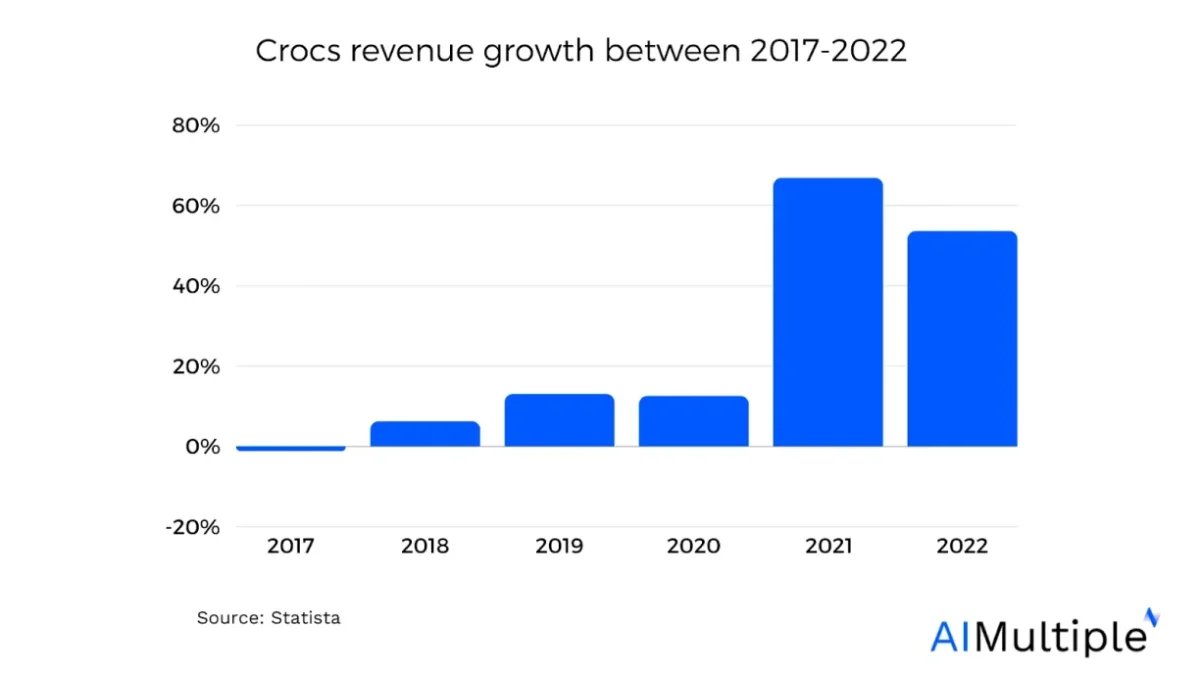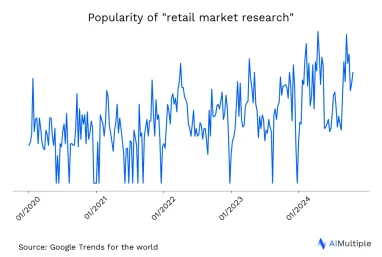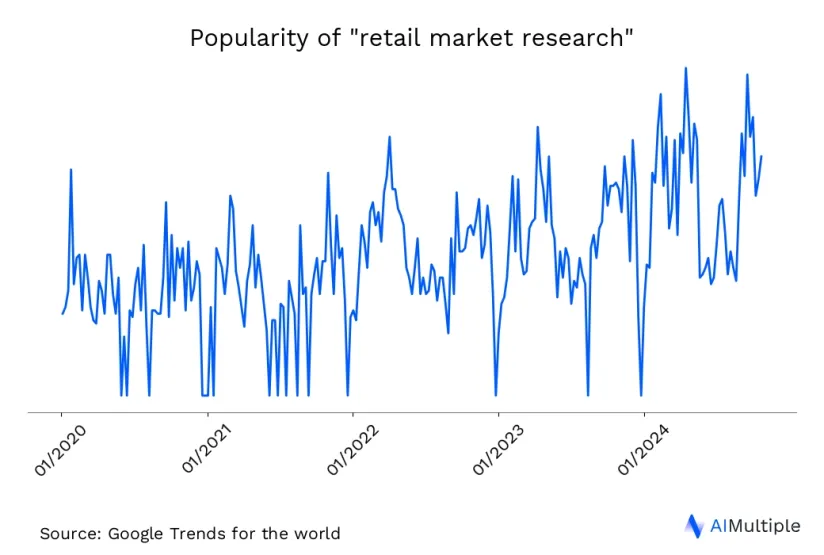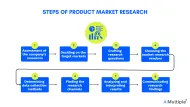A recent report highlights a dramatic shift in customer behavior, with 50% of customers changing their brand preferences, and 90% indicating they’ll continue to switch brands.1 This trend points to a volatile retail market, underlining the importance for retailers to adapt and innovate to maintain customer loyalty. With evolving consumer preferences, conducting market research through customer surveys becomes increasingly critical.
Learn about the importance of market research for retail business, methods, trends, and some real-life examples:
Why is market research important for retail companies?
If you wish to use a market research tool, here is a guide comparing the top tools on the market.
1- Better understand your target market and customers
Market research provides retailers with insights into customer behavior, enabling them to adapt their products, services, and marketing to align with market trends. This knowledge is essential for everything from product development to pricing and even store design, ensuring that retailers can create an experience that truly connects with their customers.
Real-life example
Figure 1. Crocs YoY revenue growth between 2017-2022

Source: Statista2
Crocs has experienced a nearly 200% increase in sales since 2019, outperforming other brands that peaked during quarantine.3 Emphasizing digital marketing, market research, and celebrity endorsements, Crocs continues to adapt to consumer needs, moving towards a more fashion-forward market and maintaining relevance despite changing trends.
2- Increase product launch success
Introducing a new product to the market is a high-stakes endeavor, often accompanied by considerable financial risk. Conducting thorough market research is key to mitigating these risks. By delving into consumer desires, market trends, and unmet needs, retailers can gain valuable insights that guide product development.
Real-life example
A recent survey by the Toy Association found that more than 40% of adult parents are buying toys for themselves.4 This trend, known as the “kidult” market, has seen growth, particularly during the pandemic. Retailers like Walmart are responding by marketing toys and games directly to adults, tapping into this nostalgic consumer segment.
3- Stay informed about and ahead of competitors & retail industry trends
Staying abreast of industry trends and understanding what rivals are doing is crucial in retail. Retailers must be aware of their competitors’ offerings and identify areas where they can differentiate themselves, be it in product characteristics, customer experience, or communication strategies.
Real-life example
Home Depot identified a trend towards convenient and seamless shopping experiences and responded by integrating advanced technologies.5 They developed a versatile mobile app that facilitates price comparison and in-store pickups, augmented reality for visualizing products in a space, and location-based services within the app to enhance in-store navigation and offer real-time deals to customers.
4- Improve marketing messaging and customer relationships
Through market research, retailers can gain insights into consumer behaviors, preferences, and purchasing motivations. This information is invaluable for developing targeted marketing campaigns that resonate with consumers, enhancing the overall customer experience, and building lasting relationships.
Understanding customer needs and preferences allows retailers to communicate more effectively, personalize their marketing efforts, and align their products and services with consumer expectations, thereby fostering customer loyalty and driving sales.
Real-life example
McDonald’s responded to customer feedback about the lack of healthy and organic options on its menu.6 As a result, McDonald’s introduced healthier items like apple slices and launched an advertising campaign to highlight the real meat content in its chicken nuggets and patties, demonstrating its commitment to addressing customer concerns.
5- Validate product idea(s)
Market research helps in understanding whether there is a real demand for the product and if it meets the needs and expectations of potential customers. By effectively analyzing market trends, consumer behaviors, and preferences, retailers can reduce the risk of introducing products that may not resonate with the market.
Real-life example
Quibi, a mobile-focused streaming service, shut down after just six months due to its failure to attract a significant audience, despite raising $1.8 billion and being positioned as the next big service company in modern entertainment.7
The company’s leaders later acknowledged that the idea behind Quibi wasn’t strong enough to justify a stand-alone streaming service. This highlights how even well-funded ventures can falter without adequate market research to validate the product’s fit and demand in the market.
Primary vs. secondary research
In retail market research, primary and secondary research serve distinct yet complementary purposes. This distinction ensures a holistic approach to the market research process to understand both the micro (customer-specific) and macro (industry-wide) aspects of the retail market.
Primary research
Primary research is essential for obtaining fresh, direct feedback from customers. Through methods like surveys and interviews, retailers can gain valuable insights into consumer preferences, purchasing habits, and attitudes. This firsthand information is crucial for grasping customer behavior nuances and shaping product and marketing strategies accordingly.
Secondary research
Secondary research plays a key role in comprehensively understanding the retail sector. By analyzing existing data from sources like trade journals, government reports, and consumer studies, retailers can identify current trends, challenges, and potential opportunities for growth within the industry.
Market research methods for the retail industry
1- Customer surveys
These are questionnaires designed to collect feedback from customers about their experiences, preferences, and opinions. Surveys can be conducted online, in-store, or via email and are useful for collecting quantitative data. They help retailers understand customer satisfaction, product preferences, and areas for improvement.
2- Sentiment analysis
Sentiment analysis often uses natural language processing (NLP) and machine learning to categorize opinions as positive, negative, or neutral. This method is particularly useful in understanding how customers feel about a brand or product and can be instrumental in identifying areas for improvement, gauging customer satisfaction, and monitoring the impact of marketing campaigns or new product launches.
Check out our research on retail sentiment analysis for more information.
3- In-depth customer interviews
This method involves conducting one-on-one interviews to gain detailed insights into customer attitudes, experiences, and behaviors. These interviews can uncover deeper insights than surveys, as they allow for more nuanced discussions and exploration of topics.
4- Social media monitoring
By observing and analyzing conversations and trends on social media platforms, retailers can gauge public sentiment about their brand, competitors, and the industry at large. This method provides real-time feedback and insight into emerging trends and customer preferences.
5- Focus groups
Focus groups involve gathering a small, diverse group of people to discuss and provide feedback on products, services, or marketing campaigns. This method allows for interactive discussions and can provide rich qualitative data about consumer attitudes and behaviors.
6- Sales records
Reviewing and analyzing sales data helps retailers understand which products are selling well and which are not. This method provides concrete evidence of consumer purchasing patterns and preferences, helping retailers make informed decisions about inventory, pricing, and promotions.
Retail market trends
Retail market trends are currently shaped by several factors that companies should keep in mind when they conduct market research Here are a few:
Use of AI and technology
Artificial intelligence (AI) is revolutionizing inventory management, customer service (through chatbots), and personalized shopping experiences (through NLP). Retailers are also experimenting with augmented reality (AR/VR) to enhance product visualization online.
Omnichannel retailing practices
The line between online and offline shopping is blurring in the digitalized age. For instance, 70% of millennials and Gen Z customers rely on social channels for shopping.8 Besides, 500+ million people engage with Nike through the apps.g.9
Retailers are integrating their online and physical stores to provide a cohesive customer experience. This trend includes features like buy-online-pick-up-in-store (BOPIS) and the use of digital tools in physical stores.
Sustainable products & ethical practices
Increasingly, consumers are gravitating towards brands that demonstrate environmental responsibility and ethical business practices. This shift is leading retailers to adopt more sustainable practices, from sourcing to packaging, and transparently communicate their efforts to consumers.
Personalized products & services
With access to more customer data, retailers are tailoring shopping experiences to individual preferences. This trend involves using data analytics to offer personalized product recommendations, targeted marketing, and customized shopping experiences.
If interested, here is our data-driven list of survey participant recruitment services and survey tools.
For those interested, here is also our data driven list of market research tools..
External Links
- 1. A new playbook for retail leaders | McKinsey. McKinsey & Company
- 2. YOY revenue growth of Crocs worldwide 2024| Statista. Statista
- 3. People Started Buying Crocs During the Pandemic. They Can’t Stop. - The New York Times. The New York Times
- 4. Halloween Is for Kids. ‘Kidults’ Too. - The New York Times. The New York Times
- 5. Digital Transformation in Retail: Examples, Benefits & Trends. Ionic
- 6. 10 Famous Brands That Depend on Market Research. Drive Research
- 7. Testing Business Ideas With Market Validation | Antler Academy.
- 8. Innovating with retail technology | McKinsey. McKinsey & Company
- 9. NIKE, Inc. - Investor Relations - NIKE, Inc. Reports Fiscal 2023 Fourth Quarter and Full Year Results .





![Fake Review Detection ['25]: How it works & 3 Case Studies](https://research.aimultiple.com/wp-content/uploads/2023/01/Google-trends-data-visualization-template-9-190x107.png.webp)
Comments
Your email address will not be published. All fields are required.